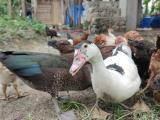Jan 11, 2007 (CIDRAP News) – The husband and son of an Indonesian woman who was being treated for H5N1 avian influenza were hospitalized with possible cases of the same illness today, and the woman died shortly afterward, according to news services.
The 37-year-old woman died today at Persahabatan Hospital in East Jakarta, according to a Kyodo News report quoting I Nyoman Kandun of the Indonesian health ministry. The woman's case was first reported Jan 8 and was confirmed by the World Health Organization (WHO) a day later.
The woman's 42-year-old husband and their 18-year-old son were hospitalized today with fever and signs of respiratory infection and were being tested for the H5N1 virus, according to a Bloomberg News report. The Kyodo News report listed the husband's age as 45.
The woman is Indonesia's 59th person to die of avian flu and the second victim this year. A 14-year-old boy died of the illness at the same hospital yesterday. Both were from Tangerang on the west side of Jakarta. Indonesia has had 76 confirmed human cases, according to the WHO.
Case clusters raise the possibility of human-to-human transmission of H5N1, which would increase the risk of a pandemic. A number of family clusters of infection have been reported, but human-to-human transmission has been proved by laboratory tests only once. The vast majority of human cases have been ascribed to contact with infected poultry.
A family cluster of 7 confirmed and 1 probable H5N1 cases in Sumatra, Indonesia, last May was attributed to person-to-person transmission. The cluster included one 3-person transmission chain and the first laboratory-confirmed instance of human transmission. Seven of the 8 people in that cluster died.
In the Sumatra cluster, all the sick people were reported to be blood relatives; no spouses contracted the disease. That observation fueled speculation about a possible genetic predisposition to the infection.
In other developments today, an asymptomatic human infection with the H5N1 virus was reported in South Korea, while poultry outbreaks of H5N1 spread to a 5th province in Vietnam.
Blood tests on a South Korean farm worker who was exposed to sick poultry during an outbreak in December showed evidence of H5N1 infection, though the worker had not been ill, according to a Bloomberg News story citing the Korea Centers for Disease Control and Prevention.
South Korea has reported evidence of aymptomatic H5N1 infections in poultry industry workers before: 5 cases last September and 4 in February. Asymptomatic cases have rarely been reported elsewhere.
The Bloomberg story noted that South Korea had 4 H5N1 outbreaks in poultry in 2006, after going more than 2 years with none.
In Vietnam, avian outbreaks have spread to a 5th province, raising concern about a nationwide resurgence of the virus, according to an Agence France-Presse (AFP) report today.
The virus killed 20 chickens on a small farm in the MeKong Delta province of Vinh Long, animal health officials in Hanoi said. Since December, the virus has also struck poultry in Ca Mau, Bac Lieu, Hau Giang, and Kien Giang provinces.
Officials have blamed the outbreaks on gaps in the country's mass vaccination program and farmers' refusal to obey a ban on hatching ducks. AFP noted that Vietnam has had no human cases since November 2005, though it had 93 cases with 42 deaths before that.
See also:
Jun 23, 2006, CIDRAP News story "H5N1 mutation showed human transmission in Indonesia"
Nov 28, 2005, CIDRAP News story "Many H5N1 cases bunched in families, report says"
Sept 21, 2006, CIDRAP News story "Five Koreans had H5N1 virus but no illness"


















